Spring 2018 EBWO3001 Portfolio on Business World Effectiveness
VerifiedAdded on 2021/04/17
|12
|2677
|436
Portfolio
AI Summary
This portfolio assignment, created for the EBWO3001 course, examines the key aspects of starting and running a business, specifically within the context of a restaurant. It begins by describing the nature of the business, outlining the advantages and disadvantages of ownership, and explaining the utility of PESTEL analysis in strategic planning. The portfolio then explores the impact of globalization, illustrating its effects with examples such as ingredient availability and supply chain management, while also suggesting technological implementations like mobile ordering and social media marketing to enhance operational efficiency and customer engagement. Furthermore, the assignment identifies the target customer base, emphasizes the importance of customer understanding, and proposes strategies for customer attraction, like social media advertising and event hosting. Finally, it addresses the role of ethics in business, emphasizing its importance in revenue generation, employee retention, and investor attraction, and discusses ethical treatment of staff using examples from other businesses. The portfolio demonstrates a comprehensive understanding of various business concepts and their practical application in a real-world setting.
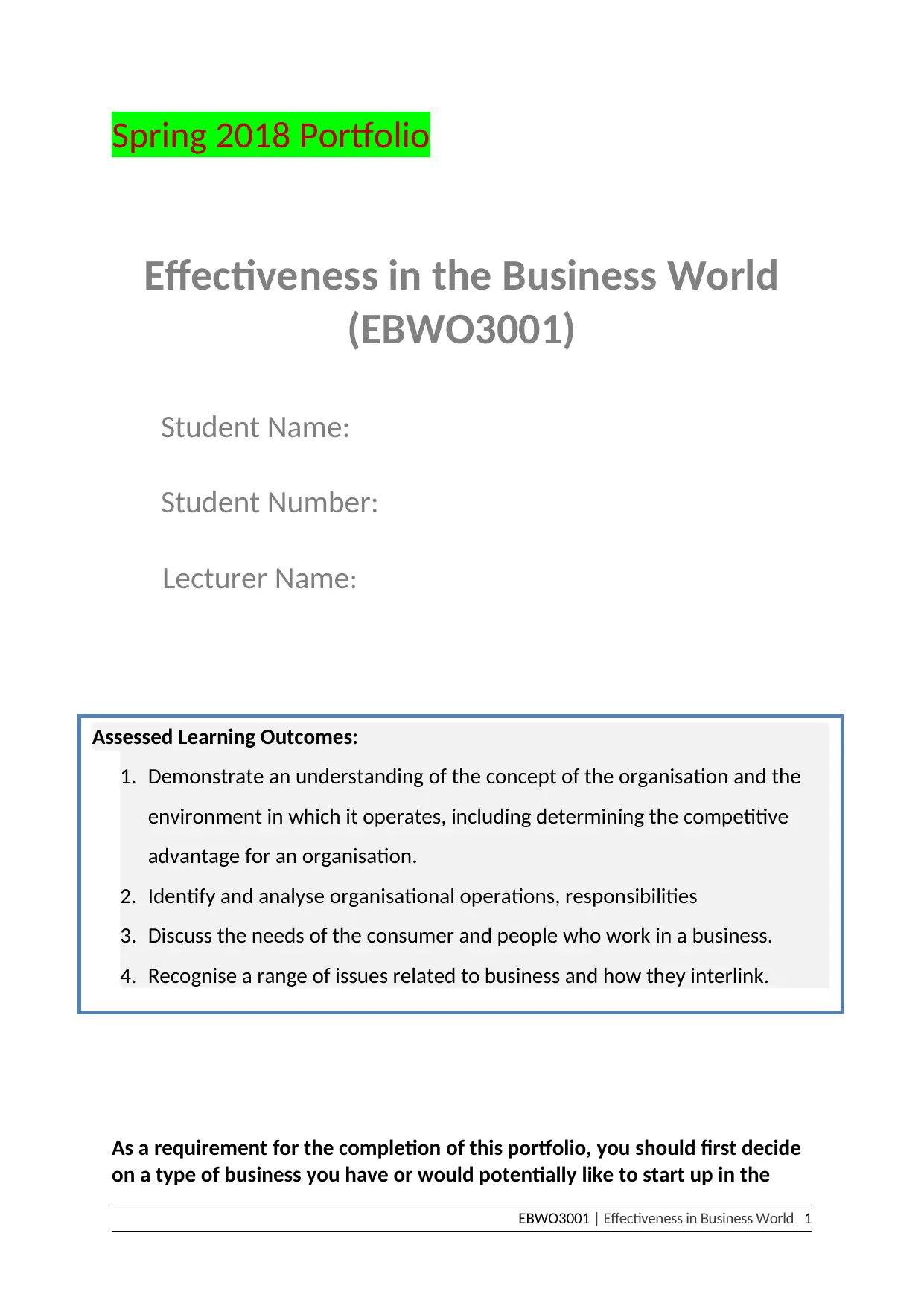
Spring 2018 Portfolio
Effectiveness in the Business World
(EBWO3001)
Student Name:
Student Number:
Lecturer Name:
As a requirement for the completion of this portfolio, you should first decide
on a type of business you have or would potentially like to start up in the
EBWO3001 | Effectiveness in Business World 1
Assessed Learning Outcomes:
1. Demonstrate an understanding of the concept of the organisation and the
environment in which it operates, including determining the competitive
advantage for an organisation.
2. Identify and analyse organisational operations, responsibilities
3. Discuss the needs of the consumer and people who work in a business.
4. Recognise a range of issues related to business and how they interlink.
Effectiveness in the Business World
(EBWO3001)
Student Name:
Student Number:
Lecturer Name:
As a requirement for the completion of this portfolio, you should first decide
on a type of business you have or would potentially like to start up in the
EBWO3001 | Effectiveness in Business World 1
Assessed Learning Outcomes:
1. Demonstrate an understanding of the concept of the organisation and the
environment in which it operates, including determining the competitive
advantage for an organisation.
2. Identify and analyse organisational operations, responsibilities
3. Discuss the needs of the consumer and people who work in a business.
4. Recognise a range of issues related to business and how they interlink.
Paraphrase This Document
Need a fresh take? Get an instant paraphrase of this document with our AI Paraphraser
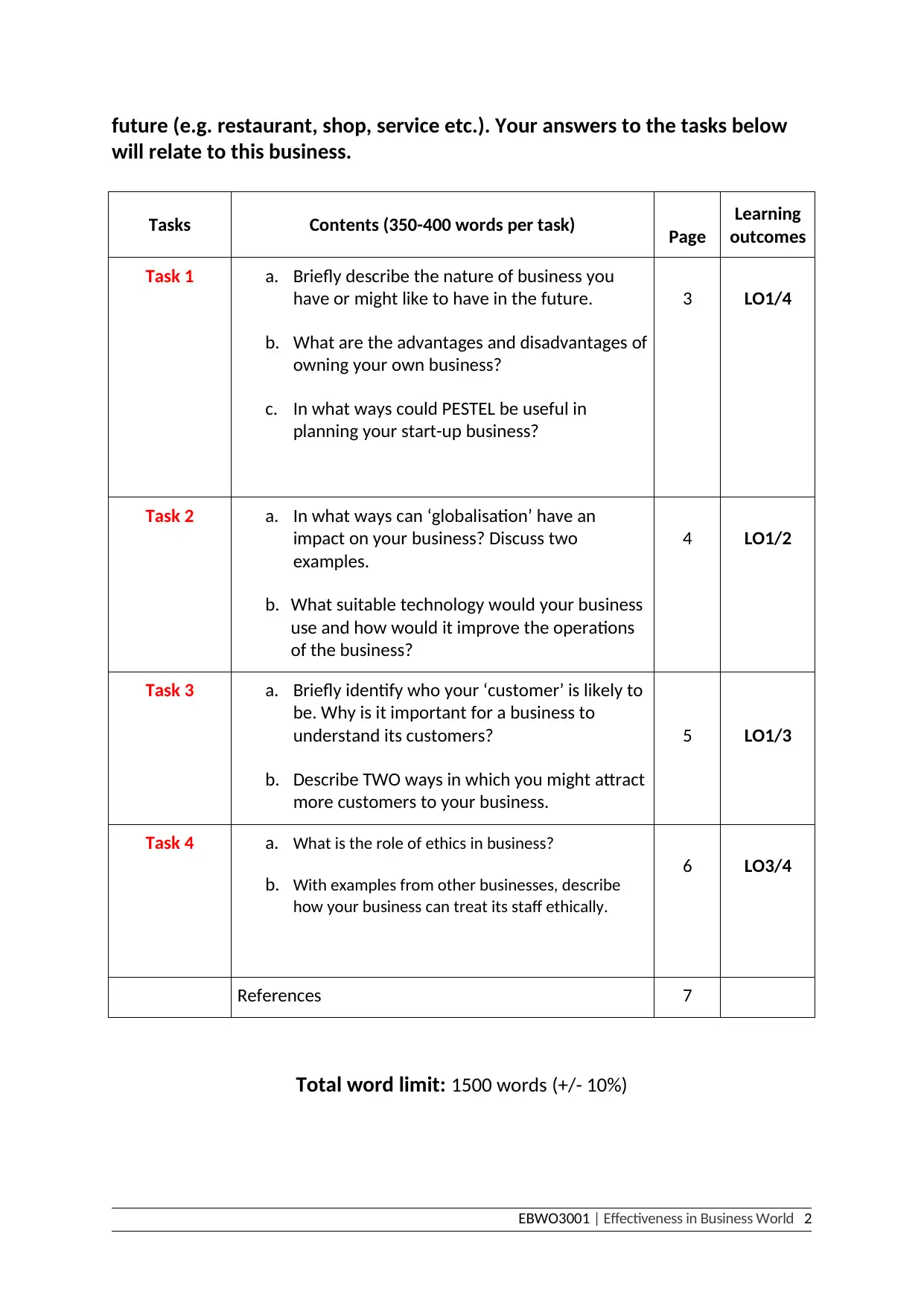
future (e.g. restaurant, shop, service etc.). Your answers to the tasks below
will relate to this business.
Tasks Contents (350-400 words per task) Page
Learning
outcomes
Task 1 a. Briefly describe the nature of business you
have or might like to have in the future.
b. What are the advantages and disadvantages of
owning your own business?
c. In what ways could PESTEL be useful in
planning your start-up business?
3 LO1/4
Task 2 a. In what ways can ‘globalisation’ have an
impact on your business? Discuss two
examples.
b. What suitable technology would your business
use and how would it improve the operations
of the business?
4 LO1/2
Task 3 a. Briefly identify who your ‘customer’ is likely to
be. Why is it important for a business to
understand its customers?
b. Describe TWO ways in which you might attract
more customers to your business.
5 LO1/3
Task 4 a. What is the role of ethics in business?
b. With examples from other businesses, describe
how your business can treat its staff ethically.
6 LO3/4
References 7
Total word limit: 1500 words (+/- 10%)
EBWO3001 | Effectiveness in Business World 2
will relate to this business.
Tasks Contents (350-400 words per task) Page
Learning
outcomes
Task 1 a. Briefly describe the nature of business you
have or might like to have in the future.
b. What are the advantages and disadvantages of
owning your own business?
c. In what ways could PESTEL be useful in
planning your start-up business?
3 LO1/4
Task 2 a. In what ways can ‘globalisation’ have an
impact on your business? Discuss two
examples.
b. What suitable technology would your business
use and how would it improve the operations
of the business?
4 LO1/2
Task 3 a. Briefly identify who your ‘customer’ is likely to
be. Why is it important for a business to
understand its customers?
b. Describe TWO ways in which you might attract
more customers to your business.
5 LO1/3
Task 4 a. What is the role of ethics in business?
b. With examples from other businesses, describe
how your business can treat its staff ethically.
6 LO3/4
References 7
Total word limit: 1500 words (+/- 10%)
EBWO3001 | Effectiveness in Business World 2
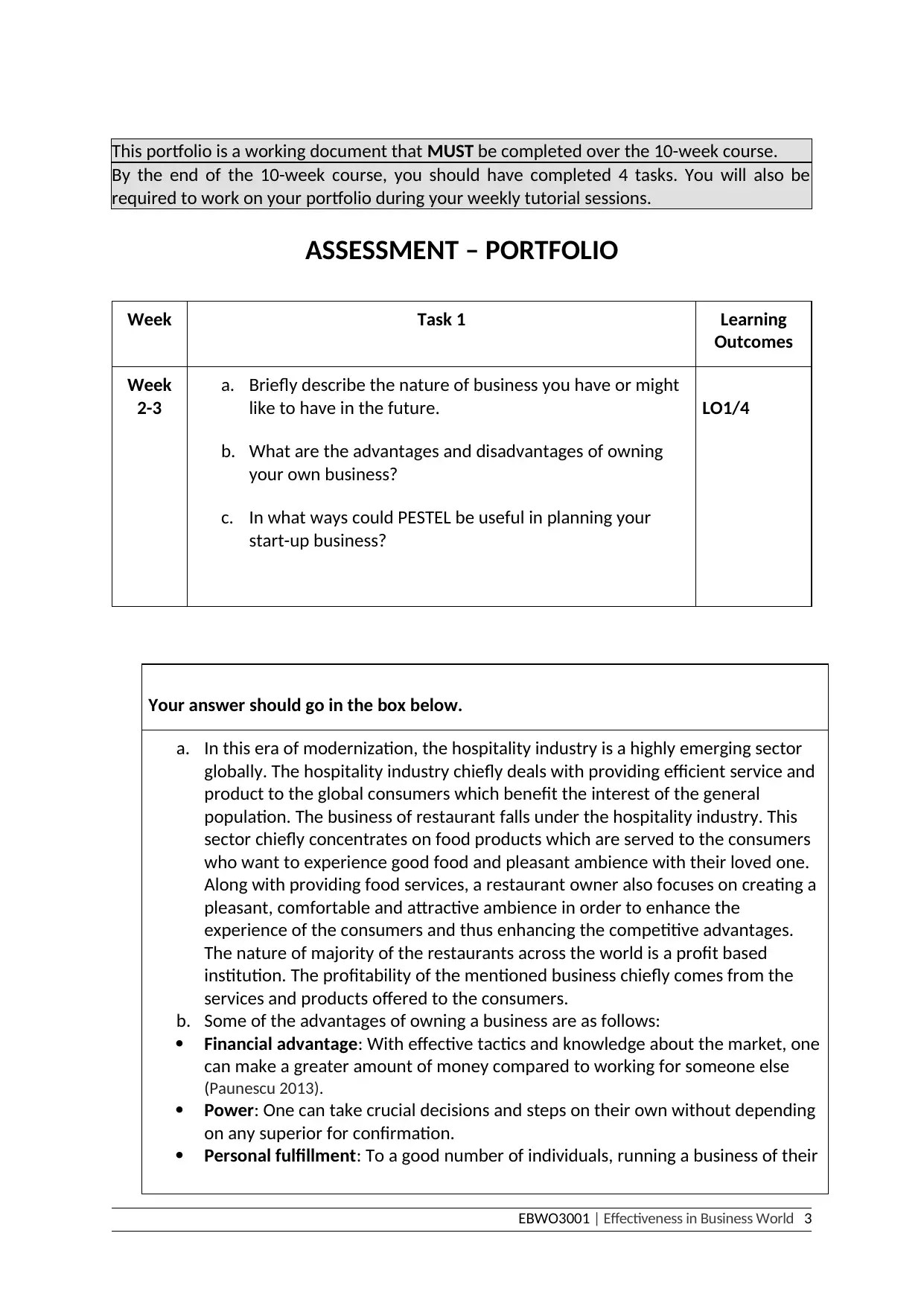
This portfolio is a working document that MUST be completed over the 10-week course.
By the end of the 10-week course, you should have completed 4 tasks. You will also be
required to work on your portfolio during your weekly tutorial sessions.
ASSESSMENT – PORTFOLIO
Week Task 1 Learning
Outcomes
Week
2-3
a. Briefly describe the nature of business you have or might
like to have in the future.
b. What are the advantages and disadvantages of owning
your own business?
c. In what ways could PESTEL be useful in planning your
start-up business?
LO1/4
Your answer should go in the box below.
a. In this era of modernization, the hospitality industry is a highly emerging sector
globally. The hospitality industry chiefly deals with providing efficient service and
product to the global consumers which benefit the interest of the general
population. The business of restaurant falls under the hospitality industry. This
sector chiefly concentrates on food products which are served to the consumers
who want to experience good food and pleasant ambience with their loved one.
Along with providing food services, a restaurant owner also focuses on creating a
pleasant, comfortable and attractive ambience in order to enhance the
experience of the consumers and thus enhancing the competitive advantages.
The nature of majority of the restaurants across the world is a profit based
institution. The profitability of the mentioned business chiefly comes from the
services and products offered to the consumers.
b. Some of the advantages of owning a business are as follows:
Financial advantage: With effective tactics and knowledge about the market, one
can make a greater amount of money compared to working for someone else
(Paunescu 2013).
Power: One can take crucial decisions and steps on their own without depending
on any superior for confirmation.
Personal fulfillment: To a good number of individuals, running a business of their
EBWO3001 | Effectiveness in Business World 3
By the end of the 10-week course, you should have completed 4 tasks. You will also be
required to work on your portfolio during your weekly tutorial sessions.
ASSESSMENT – PORTFOLIO
Week Task 1 Learning
Outcomes
Week
2-3
a. Briefly describe the nature of business you have or might
like to have in the future.
b. What are the advantages and disadvantages of owning
your own business?
c. In what ways could PESTEL be useful in planning your
start-up business?
LO1/4
Your answer should go in the box below.
a. In this era of modernization, the hospitality industry is a highly emerging sector
globally. The hospitality industry chiefly deals with providing efficient service and
product to the global consumers which benefit the interest of the general
population. The business of restaurant falls under the hospitality industry. This
sector chiefly concentrates on food products which are served to the consumers
who want to experience good food and pleasant ambience with their loved one.
Along with providing food services, a restaurant owner also focuses on creating a
pleasant, comfortable and attractive ambience in order to enhance the
experience of the consumers and thus enhancing the competitive advantages.
The nature of majority of the restaurants across the world is a profit based
institution. The profitability of the mentioned business chiefly comes from the
services and products offered to the consumers.
b. Some of the advantages of owning a business are as follows:
Financial advantage: With effective tactics and knowledge about the market, one
can make a greater amount of money compared to working for someone else
(Paunescu 2013).
Power: One can take crucial decisions and steps on their own without depending
on any superior for confirmation.
Personal fulfillment: To a good number of individuals, running a business of their
EBWO3001 | Effectiveness in Business World 3
⊘ This is a preview!⊘
Do you want full access?
Subscribe today to unlock all pages.

Trusted by 1+ million students worldwide
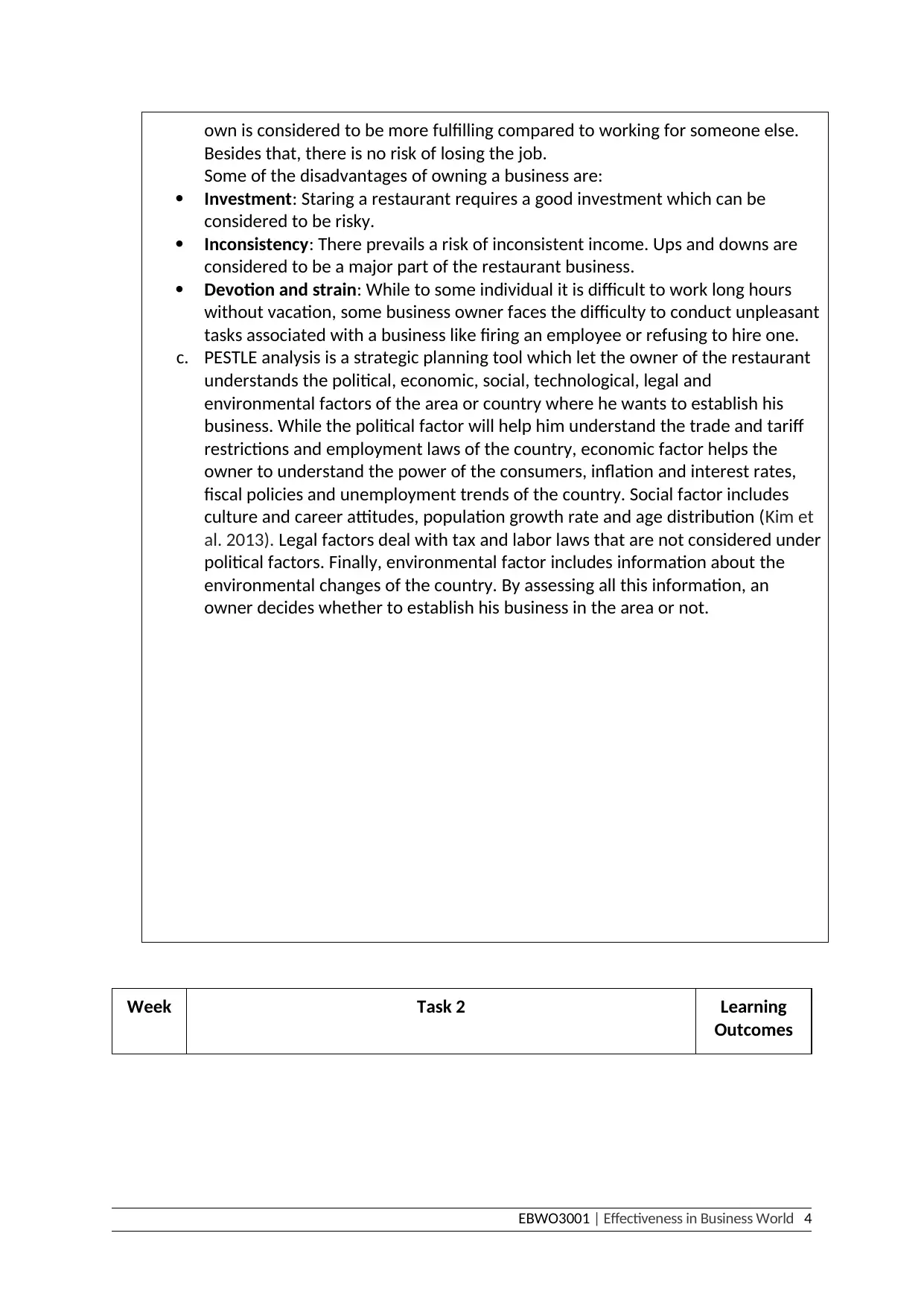
own is considered to be more fulfilling compared to working for someone else.
Besides that, there is no risk of losing the job.
Some of the disadvantages of owning a business are:
Investment: Staring a restaurant requires a good investment which can be
considered to be risky.
Inconsistency: There prevails a risk of inconsistent income. Ups and downs are
considered to be a major part of the restaurant business.
Devotion and strain: While to some individual it is difficult to work long hours
without vacation, some business owner faces the difficulty to conduct unpleasant
tasks associated with a business like firing an employee or refusing to hire one.
c. PESTLE analysis is a strategic planning tool which let the owner of the restaurant
understands the political, economic, social, technological, legal and
environmental factors of the area or country where he wants to establish his
business. While the political factor will help him understand the trade and tariff
restrictions and employment laws of the country, economic factor helps the
owner to understand the power of the consumers, inflation and interest rates,
fiscal policies and unemployment trends of the country. Social factor includes
culture and career attitudes, population growth rate and age distribution (Kim et
al. 2013). Legal factors deal with tax and labor laws that are not considered under
political factors. Finally, environmental factor includes information about the
environmental changes of the country. By assessing all this information, an
owner decides whether to establish his business in the area or not.
Week Task 2 Learning
Outcomes
EBWO3001 | Effectiveness in Business World 4
Besides that, there is no risk of losing the job.
Some of the disadvantages of owning a business are:
Investment: Staring a restaurant requires a good investment which can be
considered to be risky.
Inconsistency: There prevails a risk of inconsistent income. Ups and downs are
considered to be a major part of the restaurant business.
Devotion and strain: While to some individual it is difficult to work long hours
without vacation, some business owner faces the difficulty to conduct unpleasant
tasks associated with a business like firing an employee or refusing to hire one.
c. PESTLE analysis is a strategic planning tool which let the owner of the restaurant
understands the political, economic, social, technological, legal and
environmental factors of the area or country where he wants to establish his
business. While the political factor will help him understand the trade and tariff
restrictions and employment laws of the country, economic factor helps the
owner to understand the power of the consumers, inflation and interest rates,
fiscal policies and unemployment trends of the country. Social factor includes
culture and career attitudes, population growth rate and age distribution (Kim et
al. 2013). Legal factors deal with tax and labor laws that are not considered under
political factors. Finally, environmental factor includes information about the
environmental changes of the country. By assessing all this information, an
owner decides whether to establish his business in the area or not.
Week Task 2 Learning
Outcomes
EBWO3001 | Effectiveness in Business World 4
Paraphrase This Document
Need a fresh take? Get an instant paraphrase of this document with our AI Paraphraser
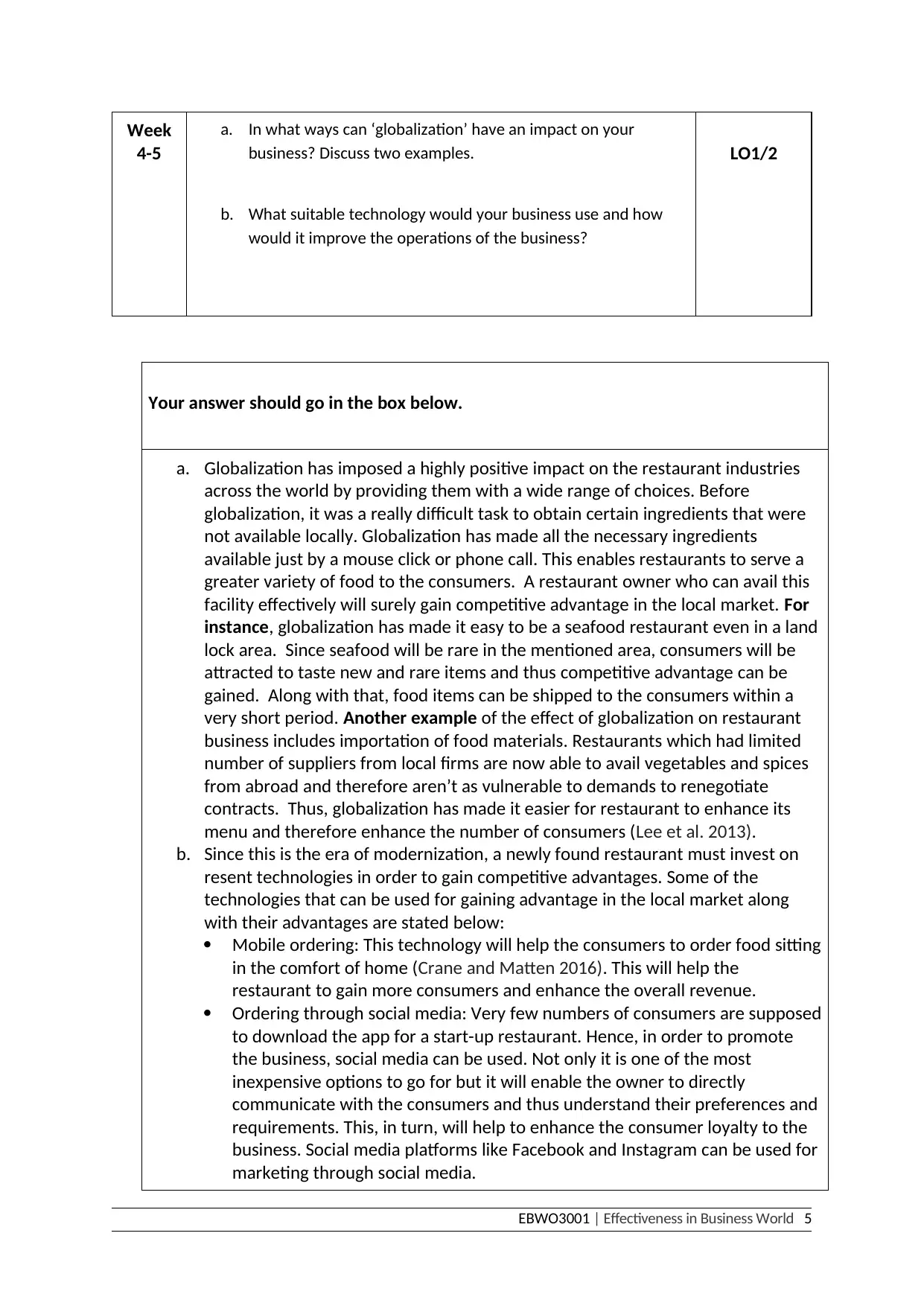
Week
4-5
a. In what ways can ‘globalization’ have an impact on your
business? Discuss two examples.
b. What suitable technology would your business use and how
would it improve the operations of the business?
LO1/2
Your answer should go in the box below.
a. Globalization has imposed a highly positive impact on the restaurant industries
across the world by providing them with a wide range of choices. Before
globalization, it was a really difficult task to obtain certain ingredients that were
not available locally. Globalization has made all the necessary ingredients
available just by a mouse click or phone call. This enables restaurants to serve a
greater variety of food to the consumers. A restaurant owner who can avail this
facility effectively will surely gain competitive advantage in the local market. For
instance, globalization has made it easy to be a seafood restaurant even in a land
lock area. Since seafood will be rare in the mentioned area, consumers will be
attracted to taste new and rare items and thus competitive advantage can be
gained. Along with that, food items can be shipped to the consumers within a
very short period. Another example of the effect of globalization on restaurant
business includes importation of food materials. Restaurants which had limited
number of suppliers from local firms are now able to avail vegetables and spices
from abroad and therefore aren’t as vulnerable to demands to renegotiate
contracts. Thus, globalization has made it easier for restaurant to enhance its
menu and therefore enhance the number of consumers (Lee et al. 2013).
b. Since this is the era of modernization, a newly found restaurant must invest on
resent technologies in order to gain competitive advantages. Some of the
technologies that can be used for gaining advantage in the local market along
with their advantages are stated below:
Mobile ordering: This technology will help the consumers to order food sitting
in the comfort of home (Crane and Matten 2016). This will help the
restaurant to gain more consumers and enhance the overall revenue.
Ordering through social media: Very few numbers of consumers are supposed
to download the app for a start-up restaurant. Hence, in order to promote
the business, social media can be used. Not only it is one of the most
inexpensive options to go for but it will enable the owner to directly
communicate with the consumers and thus understand their preferences and
requirements. This, in turn, will help to enhance the consumer loyalty to the
business. Social media platforms like Facebook and Instagram can be used for
marketing through social media.
EBWO3001 | Effectiveness in Business World 5
4-5
a. In what ways can ‘globalization’ have an impact on your
business? Discuss two examples.
b. What suitable technology would your business use and how
would it improve the operations of the business?
LO1/2
Your answer should go in the box below.
a. Globalization has imposed a highly positive impact on the restaurant industries
across the world by providing them with a wide range of choices. Before
globalization, it was a really difficult task to obtain certain ingredients that were
not available locally. Globalization has made all the necessary ingredients
available just by a mouse click or phone call. This enables restaurants to serve a
greater variety of food to the consumers. A restaurant owner who can avail this
facility effectively will surely gain competitive advantage in the local market. For
instance, globalization has made it easy to be a seafood restaurant even in a land
lock area. Since seafood will be rare in the mentioned area, consumers will be
attracted to taste new and rare items and thus competitive advantage can be
gained. Along with that, food items can be shipped to the consumers within a
very short period. Another example of the effect of globalization on restaurant
business includes importation of food materials. Restaurants which had limited
number of suppliers from local firms are now able to avail vegetables and spices
from abroad and therefore aren’t as vulnerable to demands to renegotiate
contracts. Thus, globalization has made it easier for restaurant to enhance its
menu and therefore enhance the number of consumers (Lee et al. 2013).
b. Since this is the era of modernization, a newly found restaurant must invest on
resent technologies in order to gain competitive advantages. Some of the
technologies that can be used for gaining advantage in the local market along
with their advantages are stated below:
Mobile ordering: This technology will help the consumers to order food sitting
in the comfort of home (Crane and Matten 2016). This will help the
restaurant to gain more consumers and enhance the overall revenue.
Ordering through social media: Very few numbers of consumers are supposed
to download the app for a start-up restaurant. Hence, in order to promote
the business, social media can be used. Not only it is one of the most
inexpensive options to go for but it will enable the owner to directly
communicate with the consumers and thus understand their preferences and
requirements. This, in turn, will help to enhance the consumer loyalty to the
business. Social media platforms like Facebook and Instagram can be used for
marketing through social media.
EBWO3001 | Effectiveness in Business World 5
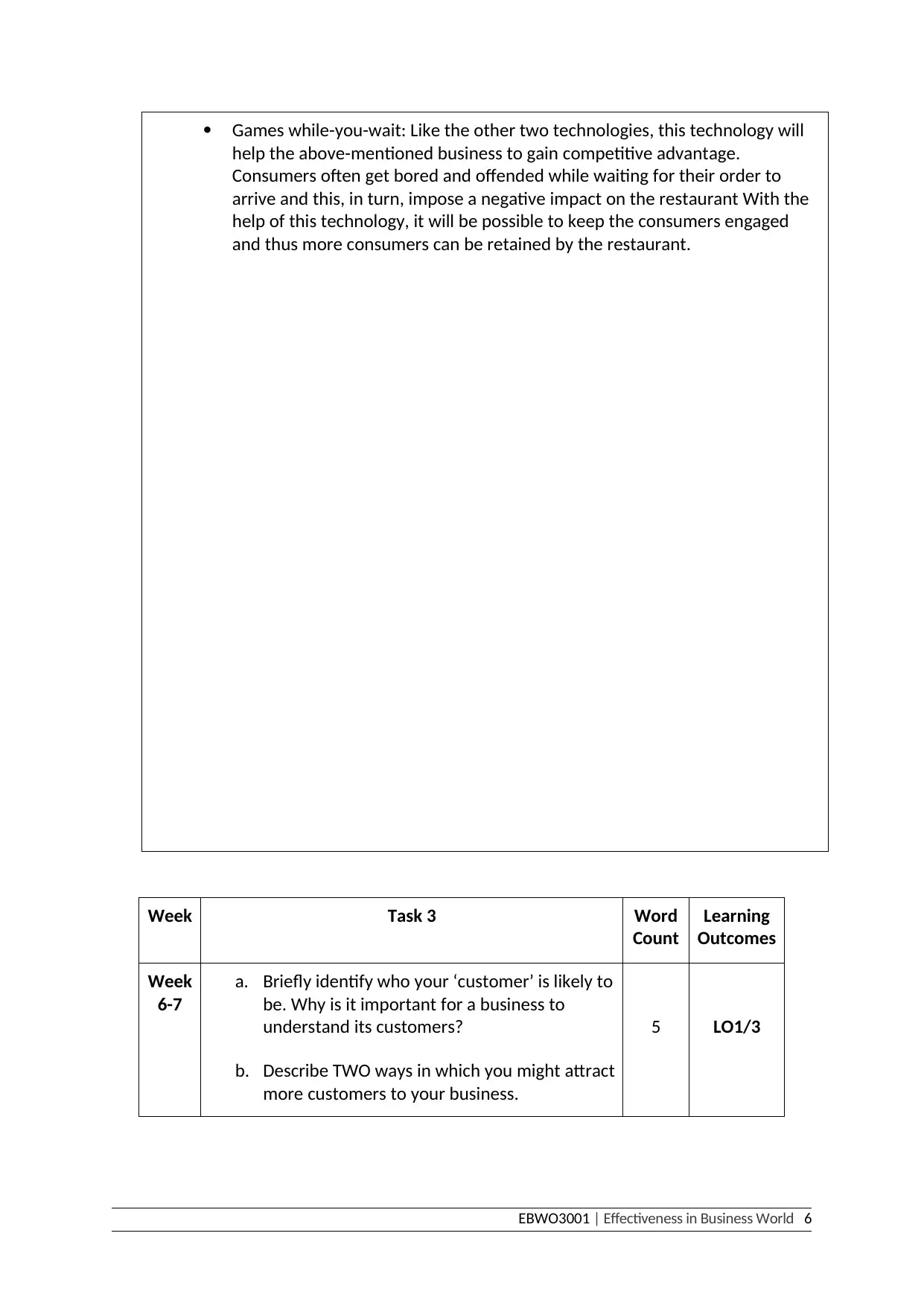
Games while-you-wait: Like the other two technologies, this technology will
help the above-mentioned business to gain competitive advantage.
Consumers often get bored and offended while waiting for their order to
arrive and this, in turn, impose a negative impact on the restaurant With the
help of this technology, it will be possible to keep the consumers engaged
and thus more consumers can be retained by the restaurant.
Week Task 3 Word
Count
Learning
Outcomes
Week
6-7
a. Briefly identify who your ‘customer’ is likely to
be. Why is it important for a business to
understand its customers?
b. Describe TWO ways in which you might attract
more customers to your business.
5 LO1/3
EBWO3001 | Effectiveness in Business World 6
help the above-mentioned business to gain competitive advantage.
Consumers often get bored and offended while waiting for their order to
arrive and this, in turn, impose a negative impact on the restaurant With the
help of this technology, it will be possible to keep the consumers engaged
and thus more consumers can be retained by the restaurant.
Week Task 3 Word
Count
Learning
Outcomes
Week
6-7
a. Briefly identify who your ‘customer’ is likely to
be. Why is it important for a business to
understand its customers?
b. Describe TWO ways in which you might attract
more customers to your business.
5 LO1/3
EBWO3001 | Effectiveness in Business World 6
⊘ This is a preview!⊘
Do you want full access?
Subscribe today to unlock all pages.

Trusted by 1+ million students worldwide
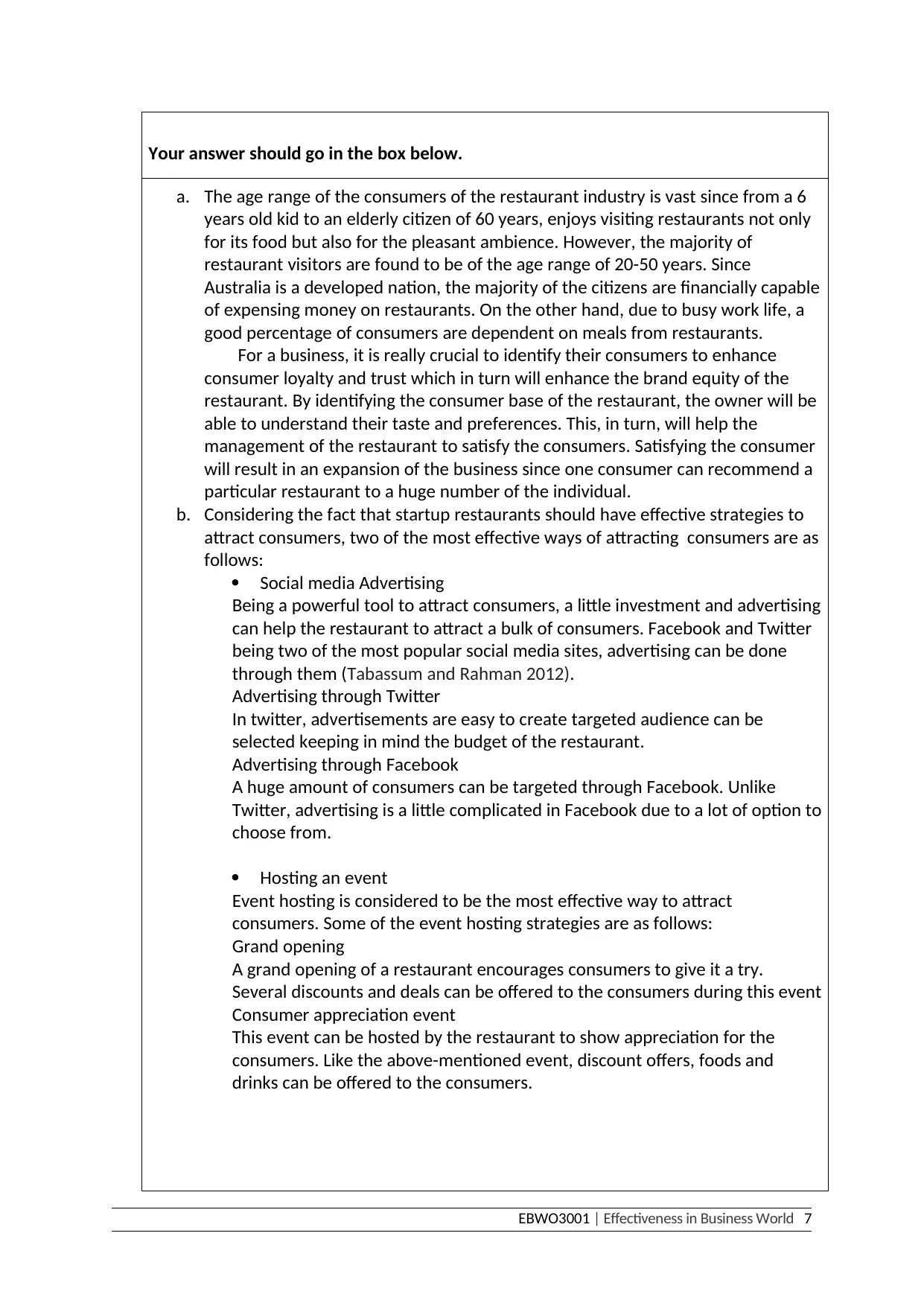
Your answer should go in the box below.
a. The age range of the consumers of the restaurant industry is vast since from a 6
years old kid to an elderly citizen of 60 years, enjoys visiting restaurants not only
for its food but also for the pleasant ambience. However, the majority of
restaurant visitors are found to be of the age range of 20-50 years. Since
Australia is a developed nation, the majority of the citizens are financially capable
of expensing money on restaurants. On the other hand, due to busy work life, a
good percentage of consumers are dependent on meals from restaurants.
For a business, it is really crucial to identify their consumers to enhance
consumer loyalty and trust which in turn will enhance the brand equity of the
restaurant. By identifying the consumer base of the restaurant, the owner will be
able to understand their taste and preferences. This, in turn, will help the
management of the restaurant to satisfy the consumers. Satisfying the consumer
will result in an expansion of the business since one consumer can recommend a
particular restaurant to a huge number of the individual.
b. Considering the fact that startup restaurants should have effective strategies to
attract consumers, two of the most effective ways of attracting consumers are as
follows:
Social media Advertising
Being a powerful tool to attract consumers, a little investment and advertising
can help the restaurant to attract a bulk of consumers. Facebook and Twitter
being two of the most popular social media sites, advertising can be done
through them (Tabassum and Rahman 2012).
Advertising through Twitter
In twitter, advertisements are easy to create targeted audience can be
selected keeping in mind the budget of the restaurant.
Advertising through Facebook
A huge amount of consumers can be targeted through Facebook. Unlike
Twitter, advertising is a little complicated in Facebook due to a lot of option to
choose from.
Hosting an event
Event hosting is considered to be the most effective way to attract
consumers. Some of the event hosting strategies are as follows:
Grand opening
A grand opening of a restaurant encourages consumers to give it a try.
Several discounts and deals can be offered to the consumers during this event
Consumer appreciation event
This event can be hosted by the restaurant to show appreciation for the
consumers. Like the above-mentioned event, discount offers, foods and
drinks can be offered to the consumers.
EBWO3001 | Effectiveness in Business World 7
a. The age range of the consumers of the restaurant industry is vast since from a 6
years old kid to an elderly citizen of 60 years, enjoys visiting restaurants not only
for its food but also for the pleasant ambience. However, the majority of
restaurant visitors are found to be of the age range of 20-50 years. Since
Australia is a developed nation, the majority of the citizens are financially capable
of expensing money on restaurants. On the other hand, due to busy work life, a
good percentage of consumers are dependent on meals from restaurants.
For a business, it is really crucial to identify their consumers to enhance
consumer loyalty and trust which in turn will enhance the brand equity of the
restaurant. By identifying the consumer base of the restaurant, the owner will be
able to understand their taste and preferences. This, in turn, will help the
management of the restaurant to satisfy the consumers. Satisfying the consumer
will result in an expansion of the business since one consumer can recommend a
particular restaurant to a huge number of the individual.
b. Considering the fact that startup restaurants should have effective strategies to
attract consumers, two of the most effective ways of attracting consumers are as
follows:
Social media Advertising
Being a powerful tool to attract consumers, a little investment and advertising
can help the restaurant to attract a bulk of consumers. Facebook and Twitter
being two of the most popular social media sites, advertising can be done
through them (Tabassum and Rahman 2012).
Advertising through Twitter
In twitter, advertisements are easy to create targeted audience can be
selected keeping in mind the budget of the restaurant.
Advertising through Facebook
A huge amount of consumers can be targeted through Facebook. Unlike
Twitter, advertising is a little complicated in Facebook due to a lot of option to
choose from.
Hosting an event
Event hosting is considered to be the most effective way to attract
consumers. Some of the event hosting strategies are as follows:
Grand opening
A grand opening of a restaurant encourages consumers to give it a try.
Several discounts and deals can be offered to the consumers during this event
Consumer appreciation event
This event can be hosted by the restaurant to show appreciation for the
consumers. Like the above-mentioned event, discount offers, foods and
drinks can be offered to the consumers.
EBWO3001 | Effectiveness in Business World 7
Paraphrase This Document
Need a fresh take? Get an instant paraphrase of this document with our AI Paraphraser

EBWO3001 | Effectiveness in Business World 8
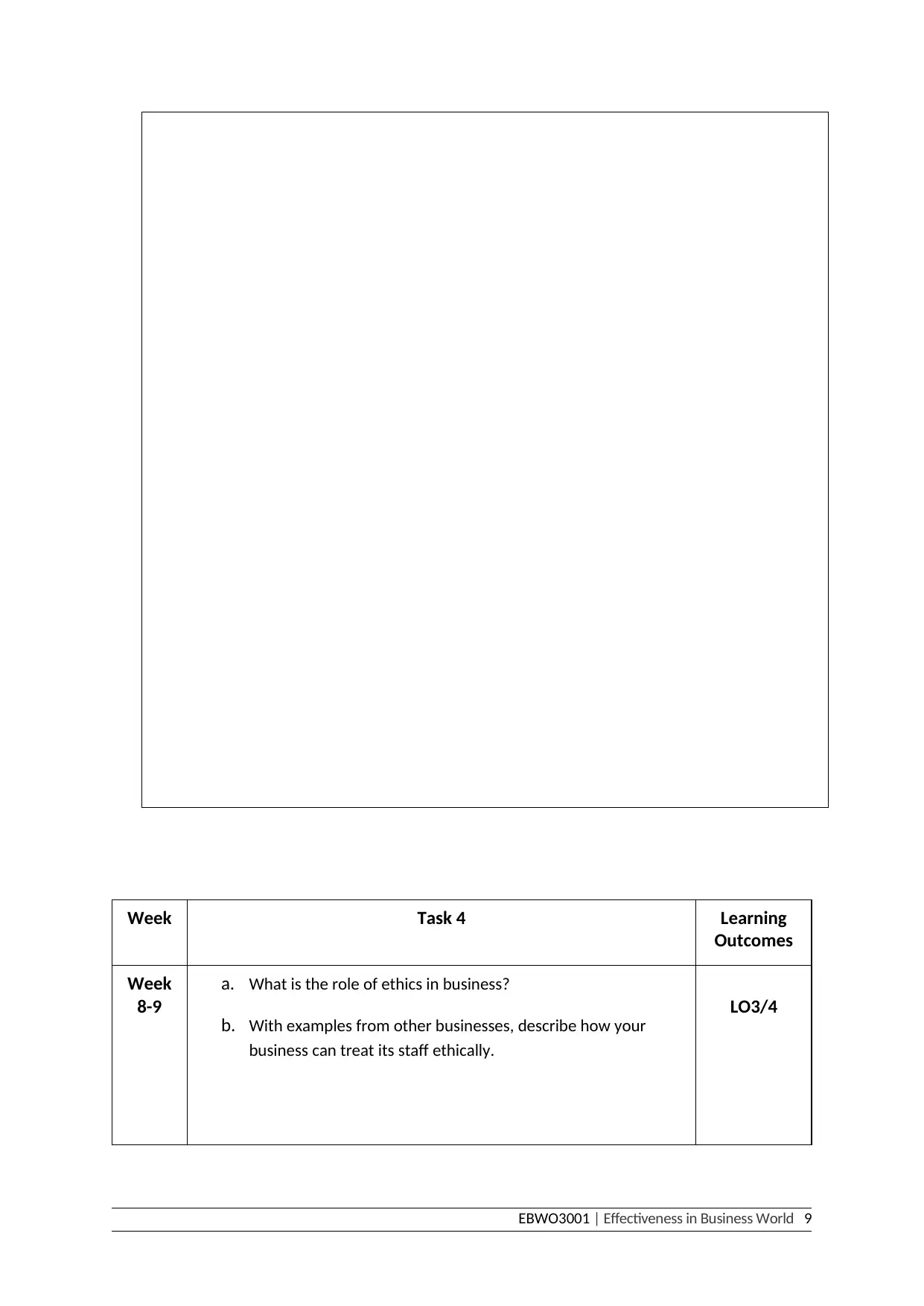
Week Task 4 Learning
Outcomes
Week
8-9
a. What is the role of ethics in business?
b. With examples from other businesses, describe how your
business can treat its staff ethically.
LO3/4
EBWO3001 | Effectiveness in Business World 9
Outcomes
Week
8-9
a. What is the role of ethics in business?
b. With examples from other businesses, describe how your
business can treat its staff ethically.
LO3/4
EBWO3001 | Effectiveness in Business World 9
⊘ This is a preview!⊘
Do you want full access?
Subscribe today to unlock all pages.

Trusted by 1+ million students worldwide
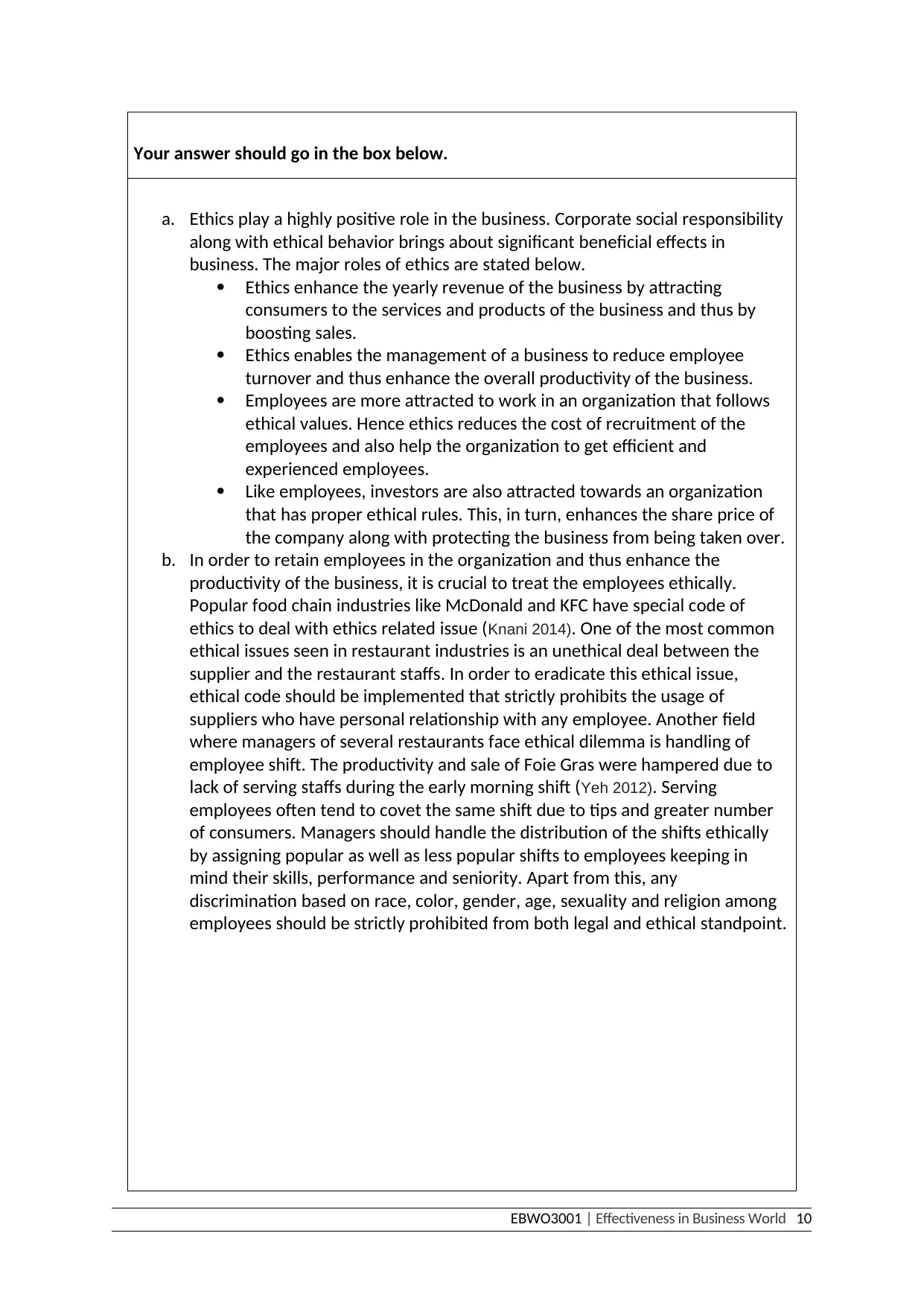
Your answer should go in the box below.
a. Ethics play a highly positive role in the business. Corporate social responsibility
along with ethical behavior brings about significant beneficial effects in
business. The major roles of ethics are stated below.
Ethics enhance the yearly revenue of the business by attracting
consumers to the services and products of the business and thus by
boosting sales.
Ethics enables the management of a business to reduce employee
turnover and thus enhance the overall productivity of the business.
Employees are more attracted to work in an organization that follows
ethical values. Hence ethics reduces the cost of recruitment of the
employees and also help the organization to get efficient and
experienced employees.
Like employees, investors are also attracted towards an organization
that has proper ethical rules. This, in turn, enhances the share price of
the company along with protecting the business from being taken over.
b. In order to retain employees in the organization and thus enhance the
productivity of the business, it is crucial to treat the employees ethically.
Popular food chain industries like McDonald and KFC have special code of
ethics to deal with ethics related issue (Knani 2014). One of the most common
ethical issues seen in restaurant industries is an unethical deal between the
supplier and the restaurant staffs. In order to eradicate this ethical issue,
ethical code should be implemented that strictly prohibits the usage of
suppliers who have personal relationship with any employee. Another field
where managers of several restaurants face ethical dilemma is handling of
employee shift. The productivity and sale of Foie Gras were hampered due to
lack of serving staffs during the early morning shift (Yeh 2012). Serving
employees often tend to covet the same shift due to tips and greater number
of consumers. Managers should handle the distribution of the shifts ethically
by assigning popular as well as less popular shifts to employees keeping in
mind their skills, performance and seniority. Apart from this, any
discrimination based on race, color, gender, age, sexuality and religion among
employees should be strictly prohibited from both legal and ethical standpoint.
EBWO3001 | Effectiveness in Business World 10
a. Ethics play a highly positive role in the business. Corporate social responsibility
along with ethical behavior brings about significant beneficial effects in
business. The major roles of ethics are stated below.
Ethics enhance the yearly revenue of the business by attracting
consumers to the services and products of the business and thus by
boosting sales.
Ethics enables the management of a business to reduce employee
turnover and thus enhance the overall productivity of the business.
Employees are more attracted to work in an organization that follows
ethical values. Hence ethics reduces the cost of recruitment of the
employees and also help the organization to get efficient and
experienced employees.
Like employees, investors are also attracted towards an organization
that has proper ethical rules. This, in turn, enhances the share price of
the company along with protecting the business from being taken over.
b. In order to retain employees in the organization and thus enhance the
productivity of the business, it is crucial to treat the employees ethically.
Popular food chain industries like McDonald and KFC have special code of
ethics to deal with ethics related issue (Knani 2014). One of the most common
ethical issues seen in restaurant industries is an unethical deal between the
supplier and the restaurant staffs. In order to eradicate this ethical issue,
ethical code should be implemented that strictly prohibits the usage of
suppliers who have personal relationship with any employee. Another field
where managers of several restaurants face ethical dilemma is handling of
employee shift. The productivity and sale of Foie Gras were hampered due to
lack of serving staffs during the early morning shift (Yeh 2012). Serving
employees often tend to covet the same shift due to tips and greater number
of consumers. Managers should handle the distribution of the shifts ethically
by assigning popular as well as less popular shifts to employees keeping in
mind their skills, performance and seniority. Apart from this, any
discrimination based on race, color, gender, age, sexuality and religion among
employees should be strictly prohibited from both legal and ethical standpoint.
EBWO3001 | Effectiveness in Business World 10
Paraphrase This Document
Need a fresh take? Get an instant paraphrase of this document with our AI Paraphraser
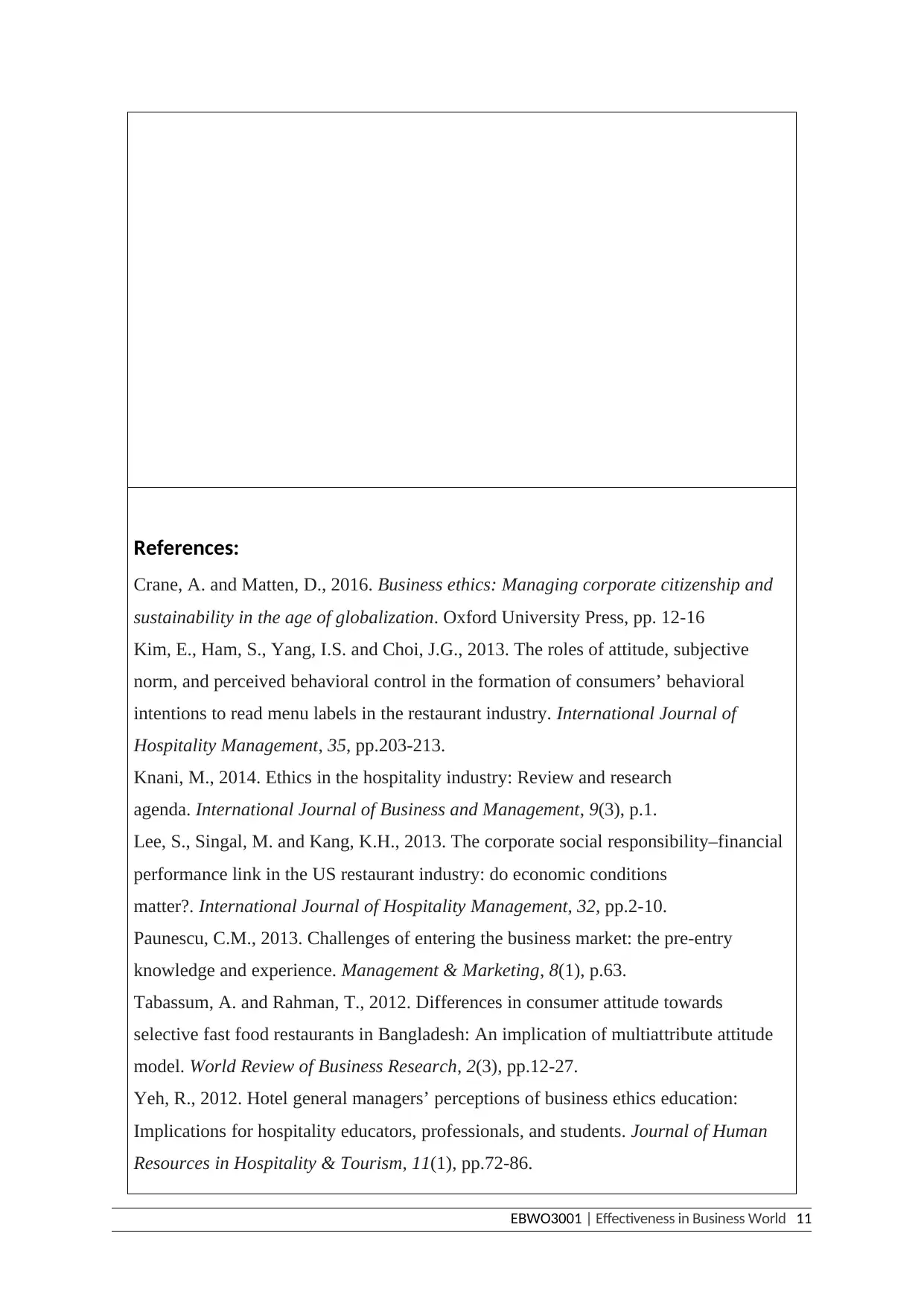
References:
Crane, A. and Matten, D., 2016. Business ethics: Managing corporate citizenship and
sustainability in the age of globalization. Oxford University Press, pp. 12-16
Kim, E., Ham, S., Yang, I.S. and Choi, J.G., 2013. The roles of attitude, subjective
norm, and perceived behavioral control in the formation of consumers’ behavioral
intentions to read menu labels in the restaurant industry. International Journal of
Hospitality Management, 35, pp.203-213.
Knani, M., 2014. Ethics in the hospitality industry: Review and research
agenda. International Journal of Business and Management, 9(3), p.1.
Lee, S., Singal, M. and Kang, K.H., 2013. The corporate social responsibility–financial
performance link in the US restaurant industry: do economic conditions
matter?. International Journal of Hospitality Management, 32, pp.2-10.
Paunescu, C.M., 2013. Challenges of entering the business market: the pre-entry
knowledge and experience. Management & Marketing, 8(1), p.63.
Tabassum, A. and Rahman, T., 2012. Differences in consumer attitude towards
selective fast food restaurants in Bangladesh: An implication of multiattribute attitude
model. World Review of Business Research, 2(3), pp.12-27.
Yeh, R., 2012. Hotel general managers’ perceptions of business ethics education:
Implications for hospitality educators, professionals, and students. Journal of Human
Resources in Hospitality & Tourism, 11(1), pp.72-86.
EBWO3001 | Effectiveness in Business World 11
Crane, A. and Matten, D., 2016. Business ethics: Managing corporate citizenship and
sustainability in the age of globalization. Oxford University Press, pp. 12-16
Kim, E., Ham, S., Yang, I.S. and Choi, J.G., 2013. The roles of attitude, subjective
norm, and perceived behavioral control in the formation of consumers’ behavioral
intentions to read menu labels in the restaurant industry. International Journal of
Hospitality Management, 35, pp.203-213.
Knani, M., 2014. Ethics in the hospitality industry: Review and research
agenda. International Journal of Business and Management, 9(3), p.1.
Lee, S., Singal, M. and Kang, K.H., 2013. The corporate social responsibility–financial
performance link in the US restaurant industry: do economic conditions
matter?. International Journal of Hospitality Management, 32, pp.2-10.
Paunescu, C.M., 2013. Challenges of entering the business market: the pre-entry
knowledge and experience. Management & Marketing, 8(1), p.63.
Tabassum, A. and Rahman, T., 2012. Differences in consumer attitude towards
selective fast food restaurants in Bangladesh: An implication of multiattribute attitude
model. World Review of Business Research, 2(3), pp.12-27.
Yeh, R., 2012. Hotel general managers’ perceptions of business ethics education:
Implications for hospitality educators, professionals, and students. Journal of Human
Resources in Hospitality & Tourism, 11(1), pp.72-86.
EBWO3001 | Effectiveness in Business World 11

End of Portfolio
EBWO3001 | Effectiveness in Business World 12
EBWO3001 | Effectiveness in Business World 12
⊘ This is a preview!⊘
Do you want full access?
Subscribe today to unlock all pages.

Trusted by 1+ million students worldwide
1 out of 12
Related Documents
Your All-in-One AI-Powered Toolkit for Academic Success.
+13062052269
info@desklib.com
Available 24*7 on WhatsApp / Email
![[object Object]](/_next/static/media/star-bottom.7253800d.svg)
Unlock your academic potential
Copyright © 2020–2025 A2Z Services. All Rights Reserved. Developed and managed by ZUCOL.





